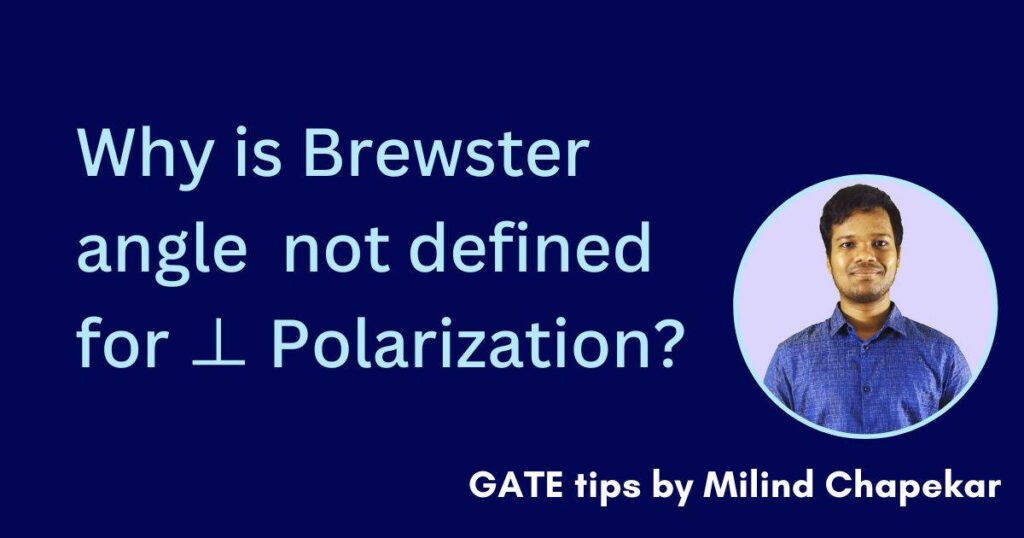Brewster angle is the angle of incidence for which the reflection coefficient is zero. But, as we know, we have two cases of polarizations viz. perpendicular and parallel.
And, you must be aware that Brewster angle is not practically defined for the perpendicular polarization. Let’s see, why?
Why Brewster angle is not defined for perpendicular polarization?
Let us first understand what is meant by Brewster’s angle in detail.
The Brewster angle is also called the polarization angle because the light that reflects from a surface at this angle is entirely polarized perpendicular to the plane of incidence.
We know that an EM wave carries electromagnetic power with it. It depends on the intrinsic impedance of the medium it travels.
When the electromagnetic wave travels from one medium to another then due to impedance mismatching some power gets transmitted into one medium while some power gets reflected back into another medium.
Every medium has its own intrinsic impedance \eta .
You can watch the quick video below or read along.
Let us understand this with the help of a diagram,
Medium 1 will have intrinsic impedance \eta_{1} and medium 2 will have intrinsic impedance as \eta_{2}. So, due to impedance mismatching, some power gets reflected back we called it a reflected wave and the remaining power which gets transmitted back into another medium is called a transmitted wave.
While studying this, you must have come across the term reflection coefficient.
Let us see the definition of the reflection coefficient, it is the ratio of the peak value of E in the reflected wave to the peak value of E in the incident wave.
\Gamma_ {\perp }=\frac{E{ro}}{E_{io}}The formula for the reflection coefficient for perpendicular polarization is
\Gamma_ {\perp }=\frac{E{ro}}{E_{io}}=\frac{\eta {2}cos\; \theta {1}-\eta {1}cos\; \theta {2}}{\eta {2}cos\; \theta {1}+\eta {1}cos\; \theta {2}}Similarly, for parallel polarization, the formula is,
\Gamma_ {|| }=\frac{E{ro}}{E_{io}}=\frac{\eta {2}cos\; \theta {2}-\eta {1}cos\; \theta {1}}{\eta {2}cos\; \theta {2}+\eta {1}cos\; \theta {1}}At certain angle of incidence, the reflected coefficient can become zero, that is called as Brewster angle.
Mathematical reason :- Let us see mathematical proof, that Why the Brewster angle is not defined for perpendicular polarization.
Practically, the media where the power is reflected and transmitted is non-magnetic.
So, for practical cases, the permeability of medium 1 is equal to the permeability of medium 2 .
i.e. \mu_{1} = \mu_{2}=\mu_{o}
Let us consider two cases :-
Case-I :- For parallel polarization
For parallel polarization, the equation will be
sin^{2}\theta {B||}= \frac{1-\frac{\mu {2}\varepsilon {1}}{\mu {1}\varepsilon {2}}}{1-\left ( \epsilon {1}/\epsilon _{1} \right )^{2}} —(2)
Here also the media is non-magnetic so, \mu_{1} = \mu_{2}=\mu_{o}
While putting values we get that in parallel polarization equation, the equation obtained after putting values is
sin^{2}\theta {B|| }= \frac{1-\frac{\varepsilon {1}}{\varepsilon {2}}}{1-\left ( \epsilon {1}/\epsilon _{2} \right )^{2}}This is a valid equation.
ii) Case-II :- For perpendicular polarization
We know that, the equation for perpendicular polarization after solving the derivation is
sin^{2}\theta {B\perp }= \frac{1-\frac{\mu {1}\varepsilon {2}}{\mu {2}\varepsilon {1}}}{1-\left ( \mu {1}/\mu _{2} \right )^{2}} —(1)
As media is non-magnetic, so \mu_{1} = \mu_{2}=\mu_{o}
But if we put \mu_{1} = \mu_{2}=\mu_{o} in eq. (1) we get the final equation as ,
sin^{2}\theta {B\perp }= \frac{1-\frac{\varepsilon {1}}{\varepsilon {2}}}{1-\left ( 1 \right )^{2}}= \frac{1-\frac{\varepsilon {1}}{\varepsilon _{2}}}{1-1}=\inftyThis is not a valid equation as we are getting infinity as the answer.
This equation does not exist.
This is the reason why the Brewster angle is not defined for perpendicular polarization.
Simple !!
Hope so , this article has given you a valid reason why the Brewster angle is not defined for perpendicular polarization.
Do not forget to check our Awesome GATE courses.


